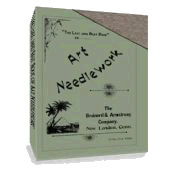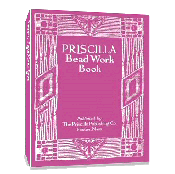Raised Embroidery Snowballs
Snowballs, a flower favored by Victorian ladies, were often used in decorative embroidery. This particular flower called for a unique raised embroidery technique to make it appear life-like. The following technique definitely fills that need!
Snowballs for ornamenting banners, corners of mirror frames, etc., are very effective and simple of construction. The background should be either plush or velvet of a rich dark color – as blue, red, or green. For working the foliage five shades of olive green arrasene, from light to dark, will be needed; work in solid Kensington stitch.
In stamping the design, transfer only the foliage and stems, as advised for the lilies. To make the snowball will require a small piece of cheese cloth or scrim, six skeins of white arrasene, a skein of palest green arrasene, a knot of pale green zephyr and a piece of cotton wool.

Click on picture to see more detail.
To work: On the scrim or cheese cloth draw a circle, using the top of a small-sized tumbler or water glass for pattern; stretch the cloth firmly in a pair of small embroidery hoops, and with the green zephyr work across the circle until the surface has been completely covered; over this prepared surface the white arrasene is to be put, and the method of doing this part of the work is identical with that described for making sumac, viz.: commence at one side of circle; bring the needle, threaded wit white arrasene, from the back of work to the surface and put down close to where it came up and pull through to the back, leaving a loop from one-half to three-quarters of an inch high on the right side; repeat this until the surface is thickly and solidly covered with these white loops; be careful to arrange the loops so they shall appear set in any particular direction, but so that they shall present a light, feathery surface.
After this part of the work has been done, take the cloth from the frame and cut out the worked circle, leaving a margin of about one-sixteenth of an inch; turn this margin under and run in a gathering thread. Do not put the gathering thread tight, but just enough to curl the edges inward; place the circle over the spot where the snowball is desired, and blind stitch it down, leaving a space of three inches at the point where it joins the stem. Into this space stuff the cotton wool, with the blunt end of the stiletto, until the snowball looks sufficiently raised, then sew down the space left and over it work in loops of the green arrasene. This will give the green cast observed at the base of snowballs.
The above method of working is very simple, and when the flower becomes soiled it is but the work of a few moments to remove it and clean in a dish of dry flour, when it can be replaced as good as new.
Snowballs are sometimes worked by putting heavy French knots of chenille over the surface, and sometimes plush stitch is employed, using filo floss to work with, but neither of these methods can compare in beauty with the one first given.
Return to top of Raised Embroidery Snowballs page.
Return to Types of Embroidery page.
Return to Specialty Designs page.
Return to Home page.Return to top of Tapestry Stitch page.
Return to Embroidery Stitches page.
Return to Home page.



 433 pages!
433 pages!

